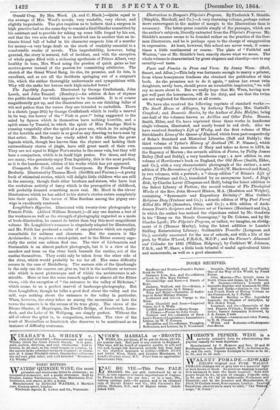Longfellow's Hyperion, Illustrated with twenty-four photographs by Francis Frith. (Alfred
William Bennett.)—If any one desires a test of the weakness as well as the strength of photography regarded as a mode of book-illustration, he cannot do better than buy this most magnificent volume. Mr. Longfellow's romance is singularly adapted for illustration, and Mr. Frith has produced a series of sun-pictures which are equally remarkable for softness and clearness. But the camera is like Archimedes; it requires a stand-point, and in the Rhine scenery espe- cially the artist can seldom find one. The view of Liebenstein and Sternenfels is an almost perfect photograph, but it is a view of the meadow and trees on the river bank beneath the castles, not of the castles themselves. They could only be taken from the other side of the river, which would probably be too far off. The same difficulty occurs in the case of Heidelberg. The eastern side of the Quadrangle is the only one the camera can give us, but it is the northern or terrace side which is most picturesque and of which the architecture is ad- mirable. More or less the same remark applies to almost all the Rhino views, with the exception of "the entrance to the valley of Birkenau," which seems to us a perfect marvel of landscape-photography. But then Longfellow, though he talks a good deal about the valley and the mill, says nothing about the entrance to the valley in particular. When, however, the story takes us among the mountains or into the towns the camera is in the scenes of its true glory. The views of the Rhone Glacier, of Meyringen, the Devil's Bridge, of Iunsbriick, Lens- deck, and the Lake of St. Wolfgang, are simply perfect. Without the aid of colour the vast is, in comparison, nowhere. The view of the tomb of Maximilian at Innsbruck also deserves to be mentioned as an instance of difficulty overcome.






























 Previous page
Previous page